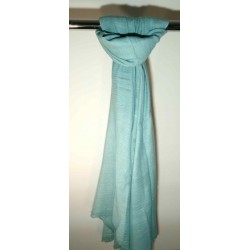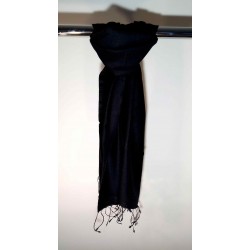Wool and Cashmere
Cashmere and Himalayan Wool
Cashmere, Pashmina, Cashmere wool, Kashmir wool, Cachemire (or cashmeer) so many names that we frequently find on our textiles, and whose meanings are doubtful, deceptive, even false. We will try here to see more clearly by detailing the exact meaning of each of these terms.
Cashmere: Cashmere (be careful with the spelling!) Is not a wool. Cashmere is a down that grows under the hair of the goat to resist winter, and falls naturally in spring. The shepherds then retrieve it with a comb, on the neck and torso of Kashmir goats (Capra Hircus Pashmina). This goat, originally from the mountains of Kashmir (Himalayan region of India), only produces cashmere from an altitude of 3800m, and generally only carries 80g of cashmere per year. In addition, this goat needs very specific climatic conditions. So the real cashmere goat can only be bred in the Himalayas, and more specifically in Ladakh, Tibet, Nepal and Bhutan.
However, in the face of increasing global demand, a hybrid goat has been developed in China which can be bred at low altitudes. 95% of the world production of Kashmir comes from this goat which is raised mainly in China (province of Inner Mongolia), Mongolia, and Central Asia. It gives a second quality cashmere which is sold widely in supermarkets.
Pashmina: From Persian pashmîneh (woolen stole), pashmina was the name given to cashmere scarves. However, the term was not protected, and it is now synonymous with scarf. You can find an acrylic pashmina, a cotton pashmina, or even silk ones. A scarf with a "100% pashmina" tag is not cashmere, but in addition is not legal, because "pashmina" does not designate a material.
Kashmir Wool (Kashmir Wool): Some smarties use this name. Kashmir is a region of India. Take any wool (sheep or whatever) raised in Kashmir, and you have Kashmir wool. Certainly not pure Cashmere anyway ...
But then, how to recognize real cashmere?
Good question, because indeed, between 80 and 90% of cashmere sold in the world is not cashmere. And this is also valid for France, because the controls are rare and the means of circumventing the law with various names (see above) are numerous.
1st golden rule: beware of cheap or discounted cashmere. If you are offered a gold bar for 20£, you can imagine that it is fake. Well for cashmere it's the same thing, we too often see cashmere scarves for less than 50 £ on the net or in stores. Merino wool at best, polyester at worst.
2nd golden rule: avoid cashmere Made in Mongolia or Made in China. Indeed, 90% of the world production of so-called cashmere would be done in Inner Mongolia (province of China) and Mongolia.
However, there is no or very little land beyond 3800m in this region of the world and the production of real cashmere is impossible there. It is therefore hybrid goat cashmere, of very inferior quality. In addition, intensive goat rearing is the main cause of desertification in Inner Mongolia. Finally, the Chinese are reputed to be the kings of counterfeit textiles.
I want a cheap cashmere scarf. How to do ?
There is no such thing as genuine cheap cashmere, but there are many other very soft and warm wools or downs; Merino wool, Yak down and wool and silk blends..
Merino
Also called poor man's cashmere, merino comes from the Merino sheep (Ovis Aries Merinos). This breed from Spain is bred mainly for its very fine wool (around 18 microns) which has very interesting characteristics. Merino wool does not itch and wicks away perspiration and moisture very quickly, and therefore prevents bad odors. It can therefore be used directly on the skin, as a T-shirt or as a scarf.
Yak down
Unlike the itchy yak hair which is used to make wigs, the yak down combed from young animals in spring is very soft and absolutely beautiful in appearance.
Our Yak down is produced by a tribe of nomadic shepherds in Ladakh between 3800 and 5000m altitude.
Cashmere
Ethiquette's cashmere is produced between 3800 and 5000m altitude in Ladakh, which gives optimum quality to the cashmere.
Silk and Wool mix
Eri Silk: a non-violent silk.
Eri silk is a silk native to Assam in northeastern India. It originates from the Bombyx Eri worm (also called Philosamia ricini), which feeds on castor, privet and lilac.
This silk with a very shiny appearance is also highly sought after, it is indeed one of the brightest silks, but also one of the rarest. Much like Tasar or Tussah silk, eri silk is not grown industrially on factory-picked and planted leaves like mulberry silk, but outdoors on trees. Its culture has remained traditional and artisanal, and forms the basis of the income of many Adivasis tribes in Assam.
Etiquette has chosen not to sell mulberry silk.
Why “non-violent” silk?
Eri silk makes it possible to produce so-called non-violent silk, because its cultivation does not involve killing the worms to harvest the silk. In fact, in the culture of other types of silk, the cocoons are harvested before the butterfly leaves, because the latter dissolves part of its silk cocoon to come out, which spoils the quality of the silk, and the makes it unusable. We therefore boil the cocoons to kill the worms before harvesting the silk.
On the contrary, the eri silk cocoon being discontinuous, the butterfly can leave it without breaking or dissolving the fibers, and the cocoon is therefore harvested after the flight of the butterfly which can continue its natural cycle.






